Kindle Paperwhite review (2015): our favorite e-reader gets even better
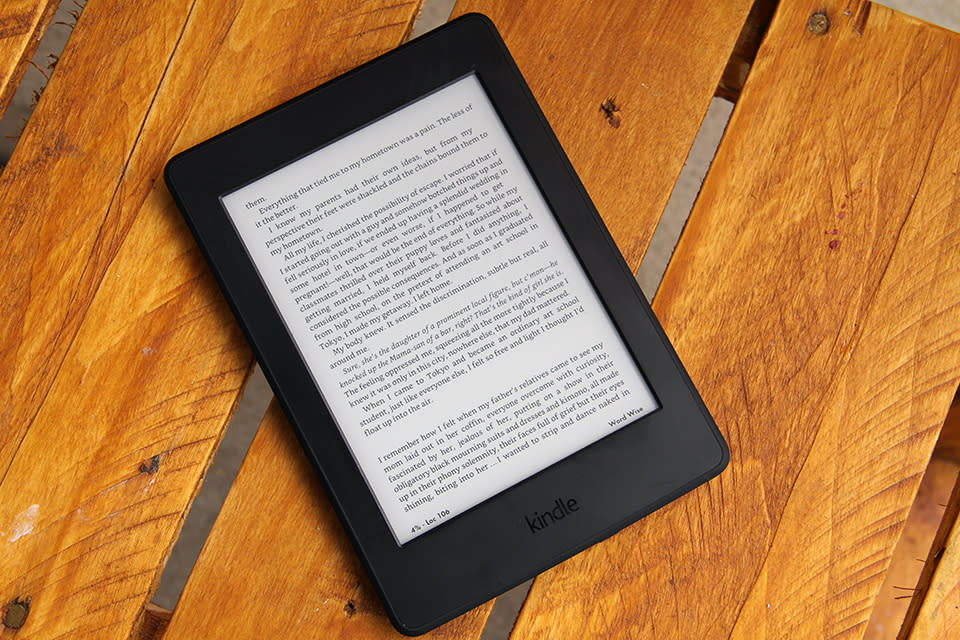
When Amazon's Kindle Voyage launched last year, I more or less fell in love with it right out of the gate. Sure, a handful of competitors came out with similar displays before Amazon did, but man -- with that high-resolution screen and its sleek new looks, the Voyage was the first Kindle that ever felt really high-end. I didn't stand a chance. Now, thanks to some trickle-down gadget economics, the new Kindle Paperwhite ($119 with ads, $139 without) just got a huge bump in screen resolution too. It was really only a matter of time, but now we're left with a question to ponder: Is a new screen enough to catapult an already-very-good reader into the realm of greatness? Spoiler alert: I think it is.
Hardware
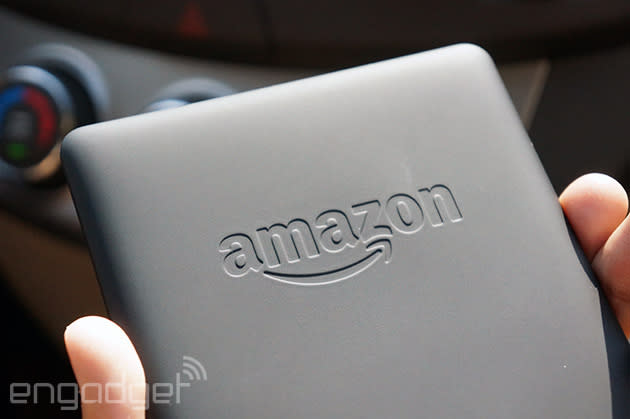
It's been years since Amazon's first Paperwhite Kindle hit the scene, and it's a bit surprising how little has changed since then. In fact, if I pulled out this latest one and showed it to you with the screen off, you'd be hard-pressed to spot any differences. That curvy, soft-to-the-touch plastic body? The placement of the micro-USB port, power button and status light? How recessed the touchscreen is? All of these physical particulars have remained the same. In fact, the only differences of note between the 2015 Paperwhite and the original are the logos embossed on the back (they now say "Amazon" instead of "Kindle") and the color of the Kindle logo right beneath the screen. The 2015 Paperwhite's look is a classic case of "if it ain't broke, don't fix it" and even a design snob like me is willing to give it a pass since it's still lightweight and nestles nicely into the hand.
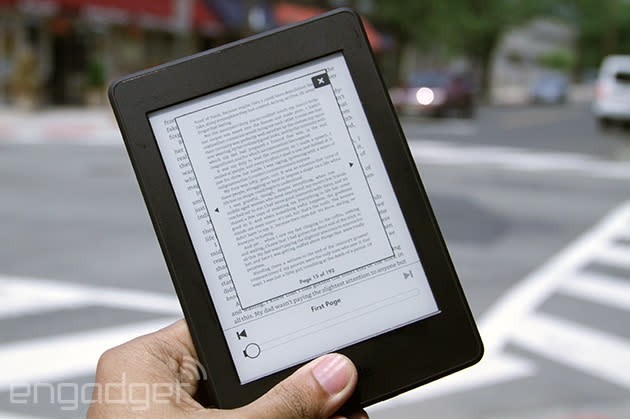
Of course, none of that means the Paperwhite's design is perfect. I'm still a little miffed that Amazon didn't enlarge the power button and slap it onto the back of the reader like it did with the Voyage. Instead, you've got to grope around for a tiny nub on the Paperwhite's bottom edge, which gets old surprisingly quickly. The screen is also still recessed into the surface of the Paperwhite's body, which can make flipping through pages ever so slightly jarring -- your finger often smacks right into the edge of that plastic bezel. Yes, I know: I'm picking nits here, but Amazon really nailed the Kindle design with the Voyage. How long until that stuff trickles down too?
Anyway, before your eyes take all that minutiae in, they'll probably settle on the 6-inch E Ink screen. This year, Amazon pumped the resolution of the Paperwhite's screen up to 300 pixels per inch, which makes for the same super-crisp text and visuals I gushed over when the high-falutin' Kindle Voyage debuted last year. It was only a matter of time, really, but that shouldn't diminish the quality of what we've got here; the thing looks great. There have been some under-the-hood improvements too, although they're tougher to spot unless you put a slew of Kindles side by side (we'll get to that shortly). Meanwhile, you've still got 4GB of storage for your digital library, and you can opt for a model with a built-in 3G radio for $70 extra.
Display and performance
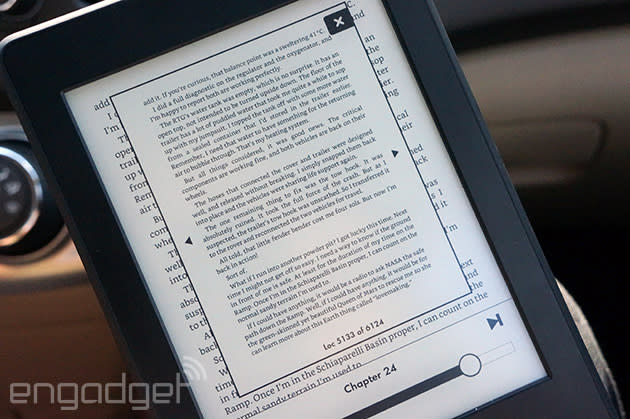
It always feels weird to lump the display and performance categories together, but with gadgets like this one, they're inextricably linked. Since the new Paperwhite's 300ppi screen is just as packed with pixels as the Voyage is, you might be tempted to gloss over this section -- don't. Yes, both Kindles offer crisp, highly readable text even when you dial down the text size, line spacing and margins. Try as I might, I couldn't make out any difference in how finely text was rendered or how quickly pages refreshed. This meant lots of gushing over the Voyage out of me last year, and just about all of it applies here too. But are they identical? No way.
The Voyage's display is a little more high-contrast, for one. It's nigh impossible to tell when you're just plowing through a novel, but the difference is more prominent if your books contain the occasional photo (or, if you're brave enough to read manga on these things). No matter what image I pulled up, the Paperwhite always came away looking less nuanced and slightly washed out compared to its more expensive cousin. This certainly isn't a dealbreaker, though, and it doesn't impact performance outdoors; it's just a reminder that Amazon had to keep costs down somehow.
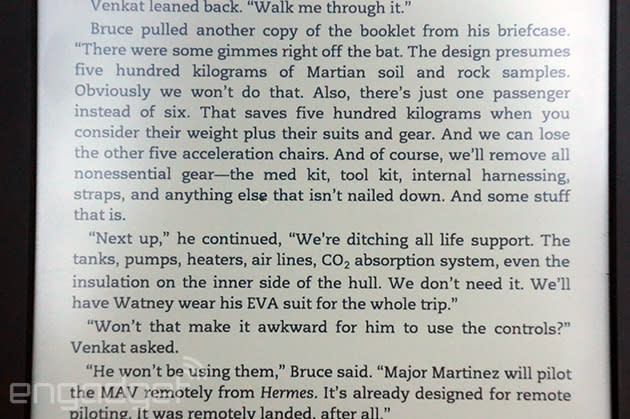
For better or worse, the Paperwhite's front-lighting system isn't as bright as the Voyage's either. That might sound like a pretty clear ding in the Paperwhite's con column, but hear me out: I actually sort of like the fact that the screen's a little dimmer. I can't remember the last time I cranked up Voyage's backlight all the way; it's way too bright for reading in the wee, dark hours of the morning and it gave the screen a distinctly bluish tinge. I'm getting into persnickety Kindle purist territory here, but it just seemed like overkill. The restraint Amazon exercised this time around means that, even at maximum brightness, the Paperwhite's pages look a little more like actual paper. (Whether or not companies like Amazon should slavishly attempt to recreate the look of mashed tree pulp is another argument entirely, but whatever; the screen is just peachy.)
Amazon seems to hate talking about the silicon that powers its Kindles, but I'm guessing the Paperwhite has the same processor and RAM as the Voyage since they're more or less identically quick. Page flips (even fast and frenzied ones) never choked up the Paperwhite, nor did sifting through Amazon's menus and book listings. It's still not completely friction-free, but we're getting very close. Naturally, none of this would mean much if it took a toll on the Paperwhite's battery, but you can cast those worries aside -- I've only topped up on juice once in the week and a half I've been testing it, and that's only because the Kindle shipped half-charged.
Software
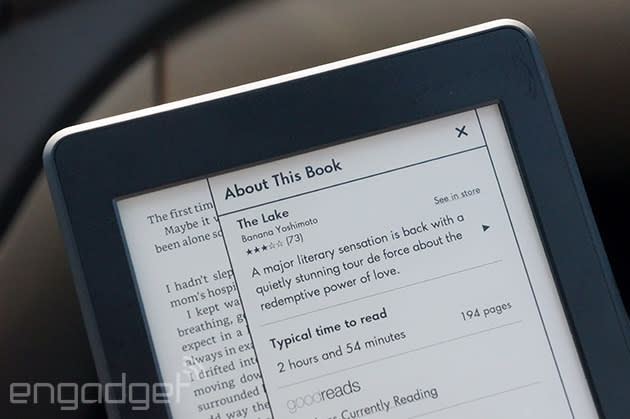
Honestly, this part's going to be a little sparse. Amazon's more a fan of occasional, over-the-air software updates so there's not a whole lot here that we haven't already seen. This year's Paperwhite is the first Kindle to get the new "Bookerly" typeface (others will get it via software update soon), which is a sleeker, more spacious alternative to the default "Caecilia." Oh, and when you first fire up the Paperwhite, it asks you if you want to turn on Word Wise, a feature that displays brief definitions above potentially tricky words. It's a neat little thing that comes in handy if you're trying to pick up English or plan on giving the Kindle to a kid, but it throws your line-spacing preferences out of whack.
The competition
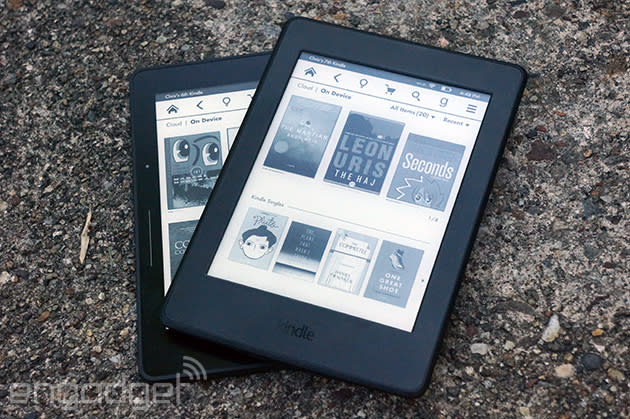
This year's Kindle Paperwhite is a fine blend of price and page-flipping performance, but keep a few other options in mind if you're not sold just yet. The Amazon-averse out there will want to consider the Kobo Glo HD, which also sports 4GB of memory and the same 6-inch, 300ppi Carta screen as the Paperwhite for $130. Yes, that's just a touch more than the most basic Paperwhite, but you're getting a reader that comes free of ads and isn't tied into Amazon's tentacular e-commerce operation. Then there's the other Kindle in Amazon's lineup with a high-res screen: the Voyage. Even if its screen and backlighting system work a little differently than the Voyage, the Paperwhite just made its cousin irrelevant to all but the nerdiest e-paper buffs. Let's run through the physical niceties that premium gets you: touch-sensitive buttons to turn pages, a much nicer design, an ambient light sensor and some chemically etched glass to cut down on that pesky glare. Really, though, it's the screen that people will flock to, and the gap in performance is so small that you shouldn't feel bad going Paperwhite over Voyage.
Wrap-up
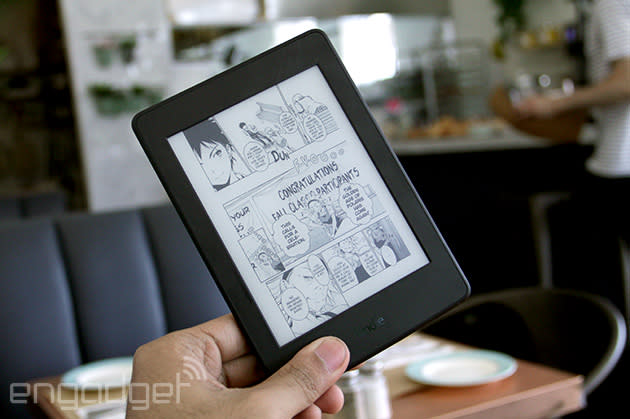
This is the third Kindle Paperwhite in as many years, and it's the first to bring a dramatic upgrade -- that mostly lovely screen -- into the fold. While the total package isn't as whiz-bang impressive as its cousin the Voyage, it's still easily the best bang for your Kindle-buying buck. If you're cool with surrendering yourself to Amazon's e-commerce empire and you're not a raging e-book nerd like me, this decision is a no-brainer: Skip the basic Kindle and the Voyage. The Paperwhite works well, looks great and will make for a lovely summer reading buddy.






















